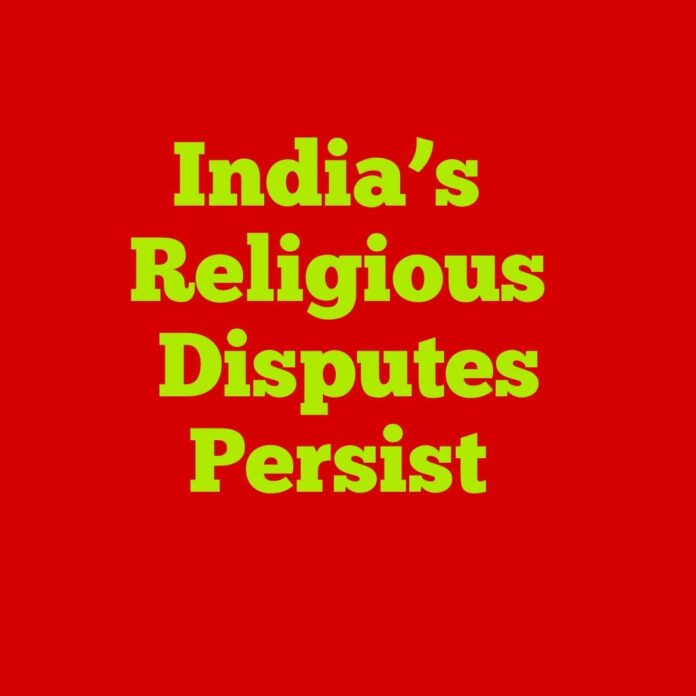
Sanjay Pandey
The Supreme Court’s recent scrutiny of the Places of Worship (Special Provisions) Act, 1991, underscores the persistent tension in India over religious sites and their historical claims. The Act mandates that the religious character of a place of worship remains as it was on August 15, 1947, barring the Ram Janmabhoomi-Babri Masjid dispute. While intended to uphold communal harmony, legal and political contestations over its validity continue to intensify. The Supreme Court’s reluctance to hear a slew of fresh petitions challenging the law reflects an ongoing struggle between historical grievances and the state’s role in maintaining religious stability.
A bench led by Chief Justice Sanjiv Khanna and Justice Sanjay Kumar expressed dissatisfaction over the flood of interim applications, signaling the difficulty of addressing the matter in the present judicial setting. Previously, the Court had put a hold on various lawsuits seeking to determine the original religious character of sites like the Gyanvapi Mosque in Varanasi and the Shahi Idgah in Mathura. With political figures such as AIMIM chief Asaduddin Owaisi and Samajwadi Party leader Iqra Choudhary advocating the law’s strict enforcement, the matter remains deeply contentious.
The crux of the legal challenge revolves around Sections 3 and 4 of the Act, which prevent judicial intervention in altering religious sites’ historical character. Petitioners like lawyer Ashwini Upadhyay argue that these provisions infringe on fundamental rights by barring legal remedies to reclaim sites that may have been modified under past regimes. In contrast, Muslim organizations such as Jamiat Ulama-i-Hind insist that any dilution of the Act could destabilize India’s delicate religious equilibrium by triggering an endless cycle of historical revisionism.
Analyzing this situation on an international level reveals stark contrasts in how different nations handle religious site disputes. The United States, for instance, operates under a robust legal framework of secularism while allowing religious organizations significant political influence. While disputes over historical religious sites are rare, when they arise, they are settled within strict legal confines without disrupting broader societal harmony. France, under its laïcité principle, enforces a rigid separation of religion and state, banning overt religious symbols in public spaces, which minimizes religious disputes but creates alienation among religious communities.
China takes an entirely different approach by maintaining strict state control over religious sites, suppressing any claims that could challenge governmental authority. The Chinese Communist Party regulates religious practices to ensure they align with nationalistic ideals, preventing any potential unrest. The United Kingdom follows a more accommodative model, allowing legal interventions in religious matters while ensuring historical grievances do not fuel contemporary discord. Historical claims are rarely entertained, and religious harmony is largely maintained through a balanced legal approach.
Unlike these models, India grapples with a deeply pluralistic but divided religious landscape, where history and faith intersect with politics at every level. The existence of multiple claims over religious sites creates a cacophony that no single legal framework can comprehensively address. The 1991 Act sought to freeze history in an attempt to prevent perpetual religious disputes, but the rising tide of petitions and political maneuvers continues to challenge its authority.
Data highlights the extent of this issue. Since 1991, there have been over 300 legal cases related to religious sites across India, with Hindu and Muslim communities both staking claims on different historical structures. The Ayodhya verdict set a precedent, but with lawsuits concerning sites such as Gyanvapi Mosque, Shahi Idgah, and Kamal Maula Mosque still active, the judiciary faces an uphill task in maintaining consistency in its rulings while preventing communal flare-ups.
The Indian judiciary’s role has been increasingly politicized, with different factions interpreting verdicts based on ideological lines. While the Supreme Court attempts to uphold constitutional principles, political parties often leverage religious site disputes for electoral gains, fueling polarization. The question remains: should the judiciary serve as the final arbiter of historical grievances, or should political consensus drive resolutions?
If the Supreme Court upholds the Places of Worship Act, it would reinforce the idea that historical grievances cannot dictate contemporary governance. However, striking down or amending the Act could open floodgates for new disputes, leading to a destabilization of the social fabric. The challenge lies in balancing historical justice with the need to preserve communal harmony. Given India’s political climate, where religion remains a potent force in public discourse, any verdict will have profound consequences.
In a country where religious identity is deeply intertwined with national politics, resolving disputes over worship sites requires more than just legal pronouncements. It necessitates a broader consensus, political will, and a commitment to social cohesion. International models demonstrate that clear legal boundaries, state neutrality, and minimal political interference can maintain harmony. India must evolve its approach, ensuring that its legal framework is not only robust but also adaptable enough to address emerging challenges without endangering secularism or social stability.
( Author, a seasoned bilingual journalist is an expert on Jharkhand’s sociopolitical landscape.He can be reached at Pandeysanjay945@gmail.com)


